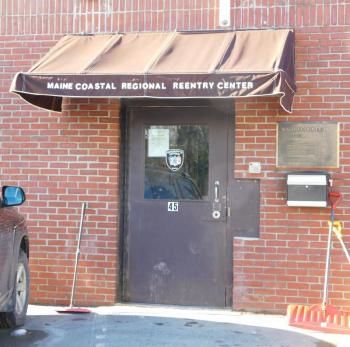BELFAST — The brown building just off Congress Street, home to the Maine Coastal Regional Reentry Center (MCRRC), is nondescript and gets little notice. Few giving much thought to the dozens of men who call the place home at any given time.
The residential facility, which is run by the Waldo County Sheriff’s Office in conjunction with Volunteers of America Northern New England (VOA), “offers transitional services to men serving the remaining 6-18 months of their state and county [jail/prison] sentences,” according to a resident handbook handed out to newcomers.
The mission is a simple: “our mission is your future.”
The Center was created after the Maine State Board of Corrections determined Waldo County Jail would be targeted for downsizing. It was the result of a state process, which began in 2008, during a time when a number of county jails came under scrutiny. The board had been tasked with reducing recidivism, finding inefficiencies, and ensuring public safety, and some jails were subsequently turned into ‘book and bail’ services with inmates held at larger facilities, such as Two Bridges Regional Jail in Wiscasset. That is where Waldo County inmates are now currently held.
In 2010, the Waldo County Jail — after an application process — assumed a different purpose and became a residential reentry center. Its doors opened to male inmates whose risk of reoffending is assessed at medium, high, or maximum risk.
The risk for reoffending is determined using a Level of Service Inventory-Revised (LSI-R) assessment, which involves classifying an offender’s likelihood to reoffend in addition to their personal criminogenic needs. The term criminogenic is used to describe a system, situation, or place that is likely to lead to criminal behavior.
The LSI-R identifies different risk factors in 10 categories, including, criminal history, education/employment, finances, family/marital circumstance, alcohol/drugs, and emotional, among others.
The assessment also identifies which of the risk factors can be positively improved, and which are unchangeable, such as criminal history.
Most offenders are able to participate in the program, though those with sexual crimes are never accepted, and those with an extensive history of domestic violence face additional scrutiny.
Those with a history of domestic violence are also less likely to be admitted to the program, though Waldo County Sheriff Jeffrey Trafton said he still looks at every individual situation.
“I look at their essay,” he said, referring to the essay each prospective candidate is required to write about his desire to enter the program.
Criminal records, including those who were arrested but not convicted, are also reviewed, in addition to their likelihood to reoffend and a number of other factors.
“You have to look at the whole picture. I can tell you that the risk to the community is at the top of all of our minds all the time. We don’t take it lightly,” he said.
Prior to becoming the MCRRC, the facility was a full-service jail, often holding 60 inmates at a time, despite being rated for 32. Before his time, Trafton said the situation then was much more dangerous than the current incarnation given the overcrowding.
There has been criticism by some Waldo County residents that citizens outside of the county are being served by the program, a facet of the program Trafton considers to be a positive one.
“People from Waldo County (WC) are our top priority. I’d love to fill the facility with WC residents, the fact is that we don’t have enough,” he said. “That’s a good thing,” he added, with a laugh.
“The state allows us to keep up to 32 residents, so then what we do is offer those beds to the local counties around us, because somebody from Bangor is not just committing crimes in Bangor, like [a man recently arrested in connection with a string of burglaries]. He’s committing crime in Waldo County, too. That’s how he ended up here,” Trafton said.
Of those from state facilities, Trafton said that many are from the area, with ties that will bring them back upon their inevitable release.
Trafton, who is a member of the Maine Sheriff Association, said the MCRRC program is known statewide, with calls often coming in from any one of 16 Maine sheriffs.
Referrals also come from any number of places, including parents of young adults in trouble, the District Attorney’s Office, defense attorneys, and from inmates themselves.
“Since the eight years the MCRRC has been open we’ve developed a sort of network. [The Sheriff’s Office] has a person, we contract with the [Volunteers of America Northern New England], and they staff our programming, we have Maine Pretrial in the facility, [the MCRRC] works with the local defense attorneys, works with our DA’s office to find eligible candidates,” he said.
“I can tell you we screen them,” he said, adding that if the prospective resident is uncooperative at their current facility, they are unlikely to be accepted into the program.
While extremely violent offenders are generally not accepted into the program, every applicant (except those with sexual offenses) is assessed.
One of the MCRRC’s current participants is a man who spent the last 27 years in state prison after being convicted of a violent crime. Trafton said he has been a model participant over the year plus course of his stay. The man, who is soon-to-graduate, also has a job and is part of a local theater group.
Before a participant can reach the higher levels, he must successfully complete his programming, which is tailored by VOA staff for each specific resident. Treatment includes cognitive behavioral therapy, which is designed to alter thought patterns and behavior. Programs take anywhere from 4-6 months to complete, which is why residents must have a sentence of longer than six months to participate.
MCRRC works on a tier system, with levels 1-4. It is when participants reach the third level that they are allowed to find a local job, though it must be within walking distance as residents are prohibited from driving.
With that freedom come conditions, including an itinerary that must be submitted several weeks in advance.
Residents must have the itineraries approved and stick to them, lest they risk being found ‘out of place,’ and risking a drop in level. Allowed to leave with enough time to walk to their location, participants are also only allotted enough time to walk back to the facility.
Weekend furloughs are often granted to residents at the higher levels, especially around the holidays.
Trafton said family reintegration is one important aspect of the programming, and it is often helpful to begin that reintegration before release. Upon return, residents are searched and screened for drugs and alcohol, with some expelled from the program after failing to abstain from drugs and alcohol on furlough.
MCRRC residents are also paired with community mentors early in the program who maintain the relationship for the first 90 days of release.
Although it is impossible to rehabilitate 100 percent of residents, Trafton said the MCRRC team is proud of its recidivism rate.
“The recidivism rate for our center, in 2015 when the MCRRC study was done, was 31 percent, so for every three that aren’t successful, we’ve got seven out there who are.”
According to a 2005 Bureau of Justice report, the national recidivism rate for prisoners released from state prisons is 67.6 percent for three years post-release, rising to 76.6 percent for five years post-release.
From the opening of the MCRRC in January 2010 through the last release date in the study, November 2014, 126 residents passed through the reentry center, with 39 reoffending in some capacity. This makes the recidivism rate of those studied 31 percent.
The same study also noted that of the 102 residents who underwent an LSI-R upon both admission to and release from the facility, 94 reduced their score on the evaluation. Of those with reductions, 70 percent left with a low or administrative level risk, which is the least likely to reoffend.
Who funds the Center?
When the Board of Correction was formed in 2008, the Waldo County Corrections budget was frozen at $2,832,353, which is where the budget remained until 2016, when the State of Maine allowed corrections funds to be increased by no more than three percent annually. Waldo County’s corrections budget was raised by 5.86 percent total, making the 2018 corrections budget $2,998,262.
While the budget for running the jail and the budget for the reentry center were roughly the same, residents of MCRRC are expected to contribute to room and board once they have secured a job.
To date, residents have paid more than $175,000 towards their own room and board, and over $137,000 towards fines and restitution.
Since its 2010 start, residents have also contributed 41,000 hours of community service work for the Waldo County municipalities, in addition to nonprofit organizations. Using a minimum wage rate of $7.50, that equates to a value of $172,095, or $369,000 using the current minimum wage rate of $9.
The Community Garden Project is paid for from the same $2,998,262 budget, with the state stipulating that 30 percent be used toward community projects, leaving the other 70 percent of the budget for corrections costs. The funds for the community garden come from that earmarked 30 percent.
This includes the 62-acre farm purchased in 2012 for $100,000, which is currently valued at $115,580. It also includes tools and vehicles purchased for the land, which Sheriff Trafton stated have been bought over time, to ensure they fit within the allotted funds.
The garden is located on Swan Lake Avenue in Swanville.
Government officials and the Waldo County Budget Committee completed a lengthy review of the 2018 county budget, which included a public hearing. The review is done annually with a budget committee that consists of local select persons from the Waldo County municipalities, who review all aspects of the budget.
Last year, the Garden Project produced more than 109,000 pounds of produce, which was then distributed among local food pantries and soup kitchens; some is also utilized at MCRRC. All of the equipment used on the farm is purchased out of the same designated fund. This includes a recently added building, which cost $40,000 to construct, Trafton said.
When asked whether the garden project affects local farmers’ financial prospects, Trafton said both he and Waldo County Commissioner William Shorey are in agreement it does not.
“[We do] not believe in any way that we’re hurting any of the farmers out there. We’ve never had any farmer in Waldo County come to us and say ‘you’re costing me business.’”
In fact, he said the project has experienced support from local farmers, from donating seeds, to volunteering to help with the farm.
The farm is worked by an average of six residents each day during its active season, which lasts roughly four months. Not everyone in the center can participate as the individualized programming for each resident always takes priority.
While the MCRRC has helped many offenders get their lives back on track, Trafton acknowledges that there are still those who will reoffend.
In a public social media post, he said in part, “my heart goes out to anyone who is a victim of a crime and that is why we work so hard with our community partners to rehabilitate the lives of the residents who pass through the reentry center.”
“We recognize the [MCRRC] has not prevented every participant from reoffending and know that no such program exists, but our goal is to continually strive to make our program better and to make our communities as safe as possible.”
“The recidivism rate for our center, in 2015 when the MCRRC study was done, was 31 percent, so for every three that aren’t successful, we’ve got seven out there who are,” he said. “So we’re doing something right.”
Erica Thoms can be reached at news@penbaypilot.com






























